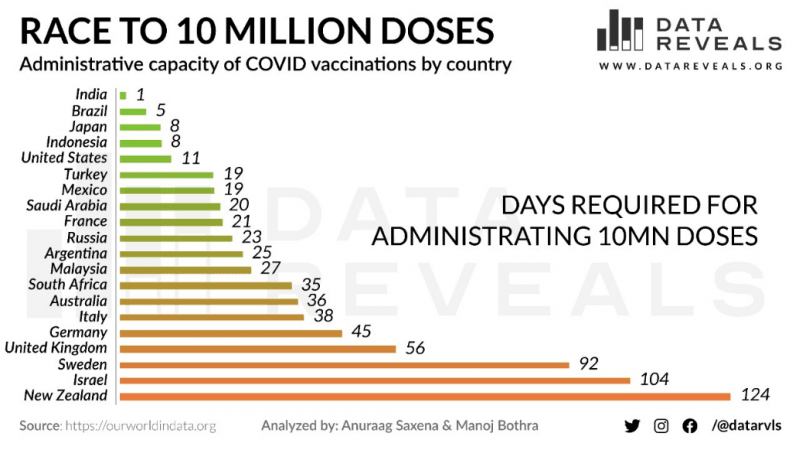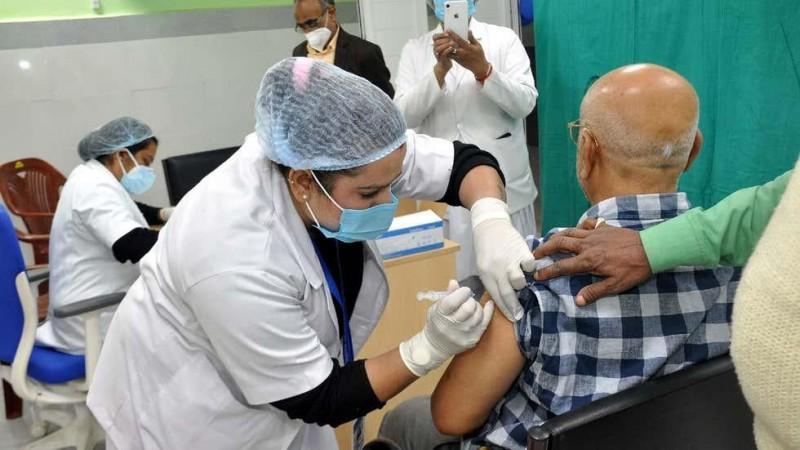India set a record on August 31, 2021, with 14 million doses of COVID vaccines administered in a span of 24 hours. India's total vaccination doses clock at 663.4 million; The month of August saw India administering over 180 million doses of the vaccine.
The scale and structure of this humongous vaccination program was unfathomable to western media, think tanks, and analysts. Unsurprisingly, western media's knee-jerk reaction was pre-emptive ridicule.
This dismissiveness has now given way to admiration amongst those that can see beyond their pejorative assumptions about India.

Refocusing the lens
The narrative on COVID vaccinations has focused on per capita numbers, and fairly so. However, this unidimensional lens does a disservice to nations that have built the administrative capacity for large-scale delivery.
Information from DataReveals shows that India vaccinates in a day, what New Zealand does in 124 days. The unidimensional narrative ignores a fundamental reality. That the whole nation of New Zealand has as many people as a mid-sized Indian city like Surat.

India vaccinates in a day, what New Zealand does in 124 days
"Developed" nations like Germany and the United Kingdom are 50 times slower than India, and some Nordic countries, 100 times slower.
The world at large had made a lazy assumption – that countries perceived to have cutting-edge technology, better health infrastructure, higher literacy rate, high degree of public health consciousness among its citizens; must surely be administering vaccines more quickly, efficiently, and smoothly than "third-world" India.
"Developed" nations like Germany and the United Kingdom are 50 times slower than India, and some Nordic countries, 100 times slower.

(Mis)understanding scale
Some of this disrespect comes from an abject lack of understanding of a simple concept – scale!
As Albert Bartlett once said, "The greatest shortcoming of the human race is our inability to understand the exponential function." Nations that have never had to deal with exponential numbers, tend to underestimate the effort it takes to deliver to those numbers. Calling a couple of friends over for dinner, versus catering for a small birthday party, versus running a community soup-kitchen; each needs a very different set of muscles to be built and flexed. If you've never ran a soup-kitchen, chances are you will underestimate, and under-respect, the effort it takes to run one.
(Mis)understanding resources
In 1968, German mathematician Dietrich Braess made a rather fascinating observation. When you added an additional road between points A and B, it slowed traffic down rather than speed it up. The Braess paradox, as it is now called, is a counterintuitive observation that has been studied and expanded for over half a century, with applications extending beyond mathematics and traffic management. Ian Gemp and Sridhar Mahadevan, of the University of Massachusetts, found applications of the Braess paradox in computing and artificial intelligence networks.
If that is too nerdy, let us take an example of sports. The addition of a star player can unintentionally weaken team performance due to over-reliance on that player. Simply put, in situations of crowding and limited capacity (system stress), the availability of options could actually worsen a situation instead of improving it. The COVID-19 crisis has given many systems the opportunity to stress-test their capacity.

Take India, which declared an ambitious lockdown to flatten the curve. While fairly successful in controlling the spread, except for stray incidents of super-spreaders, has left many stranded and helpless. In an unmanageable democracy of India's size, this would have led to mass starvation, medical emergencies and, in desperation, large-scale civil disobedience. But then, the Braess paradox kicked in. While citizens of many developed nations waited for governments to act, India saw communities pitching in to augment state capacity.
A cross-section of stakeholders has made this possible. Federal and State governments have been working closely; a challenge in many other countries. Seamless process and systems were put in the right place across the remotest locations. While many G-7 countries issue a paper certificate, India's is digital and can be accessed across platforms and devices. Where public capacity has failed, private hospitals and NGOs have stepped in. In short, it's a coming-of-age moment for nation where people and processes have been brought together to deal with the pandemic.
While citizens of many developed nations waited for governments to act, India saw communities pitching in to augment state capacity.
While other nations have seen counter-productive anti-mask and anti-vaxxers claiming a constitutional right, even at the risk of endangering others' lives; India and Indians seem to have normalized the scale at which effort needs to be put. The West seems to be paying a price now, with a third wave looming, and crumbling health infrastructure becoming a reality.
The biggest lesson here is to not make pejorative assumptions, that many "developed" nations seem to have made.
Every assumption comes at a cost. This one took millions of innocent lives!
- Anuraag Saxena, based in Singapore, is a board advisor and public affairs expert. He tweets at @anuraag_saxena .
- Burra Naga Trinadh is a graduate of the Lee Kuan Yew School of Public Policy and works in the development sector.
Disclaimer: The views expressed by the authors are personal









